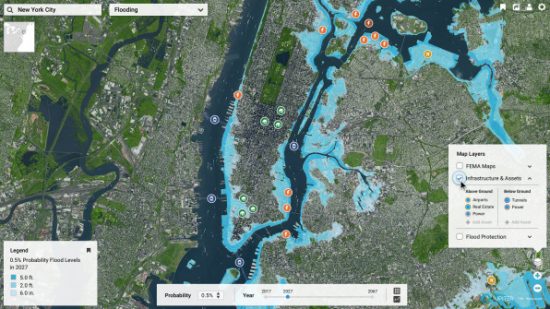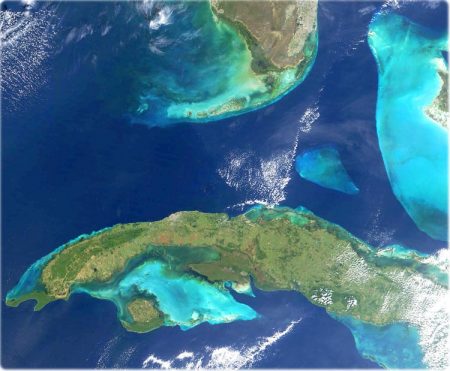February 25, 2018 – The headlines point to a future where companies will help others with mitigation and adaptation strategies. But nowhere is there news that governments are paying little more than lip service to the perils of climate change. Stories follow:
Company Creates a Climate Scoring Model Aimed at Coastal Flooding and Extreme Weather Impacts on Businesses and Cities
In an article in the New York Times this week, Brad Plumer writes that there is a business opportunity for companies with the technology to predict when and where sea level rise will occur in the next few decades. Specifically, he talks about a California startup, Jupiter, a company that describes itself as having “extreme expertise” with leading experts and risk specialists on staff that understand climate and weather, hydrography, ocean currents, and more. Among its experts are scientists from the National Oceanic and Atmospheric Administration, NASA, and other U.S. government agencies that the current administration is jettisoning. Also on board are executives from leading insurance and risk management companies, as well as advisors from Google in the area of analytics.
Jupiter is offering its forecasting and planning expertise to cities and businesses facing coastal risk, developing the Jupiter ClimateScore Intelligence Platform (TM). This includes:
- Jupiter FloodScore (TM), a model that captures complex interactions responsible for flooding and predicts areas most at risk down to individual streets and properties.
- Jupiter HeatScore (TM), a predictive modeling tool that incorporates multiple heat variables to help organizations mitigate against heat and cold-related climate impacts.
States Scott Hodgkins, Executive Vice President of Strategic Initiatives at Xebec, an air purification manufacturer, and an early Jupiter customer, “There is data but it is dated. Historical records don’t tell you the complete picture. We need data that is updated regularly and can provide predictive analysis.”

Geological Survey Reports Sea Level Rise Will Inundate U.S. Coastal Wetlands in Less Than a Century
Should we in the present be worried about a study that shows coastal marshes and habitats for wildlife vanishing in the Western United States in less than a century? Karen Thorne, a sea level rise researcher with the U.S. Geological Survey, believes we should because “wetlands provide flood protection and sequester carbon” among many other useful environmental functions.
The study which appeared in the journal Science Advances is a “first-of-its-kind comprehensive” evaluation of tidal wetlands and projected changes for 14 estuaries along the U.S. Pacific west coast. It concludes that “tidal wetlands are highly vulnerable to end-of-century submergence, with resulting extensive loss of habitat.” It predicts that 83% of current wetlands will vanish by 2110. California and Oregon will lose all of their wetlands. The state of Washington will lose 68%.
To combat this loss the study identifies ways to make these areas more resilient by two means. First, infrastructure that has depleted the replenishment of organic and silt deposits in estuaries needs to be re-engineered. That means water diversion and dams that interfere with natural riverine flows will have to be rethought. And in areas where natural replenishment cannot mitigate sea level rise, infrastructure will need to be built to ensure that these wetlands can be sustained and act as a protective barrier to stop flooding in adjacent coastal communities.
The study also notes that these wetlands represent the feeding stops for birds migrating from North to South America. Their disappearance could lead to massive die-offs in bird populations by century end.

Atmospheric Carbon Absorption in Oceans Causing Acidity Rise Which is a Risk to Coral Reefs
Coral reefs are ten times more vulnerable to acidification according to the latest study published this week in the journal Science. States lead author Bradley Eyre, Southern Cross University, in Australia, “there’s very little research that’s being done on basically carbonate sediment dissolution.” In a play on a common digestive ailment, acid reflux, the article calls the phenomenon being observed “acid reef-flux,” the study observes that dissolution of calcium carbonate in coral reefs is highly sensitive to ocean acidification which it notes is increasing because of rising levels of atmospheric carbon dioxide.
The ocean is a natural carbon sink and has been absorbing much of the emissions we humans have put into the atmosphere since the beginning of the Industrial Revolution. The result is a slow drop in pH levels throughout the entire ocean with some reefs already showing erosion and dissolution from acid corrosion. Scientists point out that the vast amount of marine life uses calcium carbonate to build outer shells to survive. That includes corals. And if coral structures start dissolving because of rising acid levels in ocean water, then reefs worldwide weather in cold or warm water are in peril. The scientists note that calcium dissolution sensitivity is 10 times greater in the presence of increasingly acidic ocean water. A drop in pH of 0.1 over a century could have catastrophic implications.
The only positive to be reported in the study is that current conditions still favour reef-building over dissolution. Modeling, however, based on current rates of acidification, suggest a “tipping point” by 2080 when coral reefs will begin to dissolve faster than they can build up. And because pH levels vary across the Earth’s ocean, the tipping point will also vary with some areas hitting it earlier and others later. By the end of the century, however, we may witness a coral reef meltdown. To illustrate recent studies indicate that reefs around Hawaii are already in meltdown, as is the Florida Reef Tract, the third largest barrier reef ecosystem on the planet.









